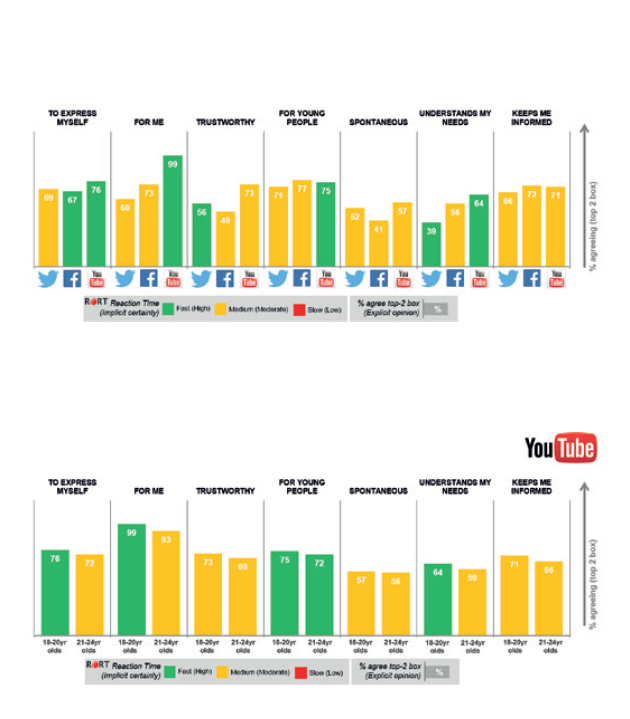Youth and Social Networks
The proportion of young people accessing social networking sites has almost reached saturation point, with as many as 30% of 16-24 year-olds in the UK classed as super high users of social media, accessing networks 10+ times per day on average. This activity is also diversifying with the increasing volume of social media sites available; social networkers typically access 5.6 diff erent social media sites in a month. Often described as “digital natives”, growing up in an always on world, social networks form a significant part of young people’s lives and act as an important source of socialization. But what is the relationship between young people and social networks? Are some more important to them than others? What types of conversations and engagements are they looking for on these different networks?
Understanding where and how to engage with young people on social networks raises important questions, particularly for brands and companies that are looking to have meaningful conversations and build relationships with young people. At Walnut Unlimited we wanted to understand the nature of the emotional connection young people (18-24 year-olds) have with the social networking sites they use and explore and what this means for brands and companies trying to build meaningful connections with young people through these networks.
The specific research questions we were looking to test were:
1. What emotional connections do young people have with social networks?
2. Are all young people the same? Specifically, do differences exist between 18-20 year-olds and
21-24 year-olds?
3. Should brands use the same content to engage with young people on all networks?
We invited 160 social media users, aged between 18 and 24 years old, to take part in a short online survey consisting of a series of questions about social media usage that included an implicit test. The implicit test measures the speed of response between a specific social media site and a particular attribute or statement, e.g. Facebook is for me. This can be used to understand both the explicit response, i.e. whether they agree or disagree that Facebook is for them, and also the strength of the connection by measuring the implicit reaction. The faster the response, the stronger the connection in the brain between the brand and the particular statement, indicating that greater emotional certainty exists between the social media site and the particular attribute. As the connected generation, this approach was chosen as it allows for a very quick online test. Given the high diversity of using different networking sites we also anticipated that there would be little variation between the brands on an explicit level only. Therefore, using an implicit test allowed a deeper understanding of the emotional connection of young people with the selected social networks.
For this implicit test we presented three social media networks to respondents; Facebook, Twitter, and YouTube. For each brand, respondents were asked to answer as quickly as possible, whether they agreed or disagreed that the given attribute described the social media brand presented. The attributes used were: ‘for me’, ‘to express myself’, ‘trustworthy’, ‘for young people’, ‘understands my needs and reliable’.
On the explicit, declared-response level, with the exception of YouTube ‘being for me’, there appears to be little difference in how young people perceive the three social media networks, with similar levels of agreement that Twitter, Facebook and YouTube allow them to ‘express themselves’, ‘is for young people’, ‘spontaneous’ and ‘keeps me informed’
.
However, looking at the implicit speed of response scores, we see that there are distinct differences in the strength of connection that young people have with particular social networks. There is consistency with the explicit responses for YouTube and ‘for me’, whereby the emotional reaction reflects the high % agreement at the explicit level. But there are also differences identified by the implicit data. Fast responses are seen for YouTube being for young people, to express myself and understands my needs. YouTube being ‘for young people’, ‘to express myself’ and ‘understands my needs’. Facebook is also rated as ‘being to express myself’ with a strong level of conviction amongst young people. For Twitter, there is a strong connection ‘for young people’ for it being ‘trustworthy’ and is also rated for ‘understanding my needs’ for a passionate minority.

Looking at YouTube more closely, we see that differences exist between 18-20 year-olds and 21-24 year-olds in their connection with YouTube. The 18-20 year-olds are driven by the affinity with YouTube for ‘to express myself’, ‘for me’ and ‘understands my needs’.
“18-20 year-olds have a stronger emotional connection with YouTube than 21-24 year-olds.” YouTube has the highest affinity with young people, and shows the strength of brand values, for me, for young people, and understands my needs. All of which relate to a sense of identity, that YouTube is seen as part of their lives and has become a friend and trusted advisor.
However not all young people are the same: without using reaction-time tools, the differences between 18- 20 year-olds and 21-24 year-olds would have otherwise remained hidden and a conclusion could have been that activity targeted via YouTube should have the same effect on both age groups –whereas this is not the case. 18-20 year-olds have a stronger emotional connection with YouTube than 21-24 year-olds.
These results demonstrate the deeper layer of insight that neuroscience tools can provide by going beyond what people outwardly declare, and can be used in addition to traditional research techniques. This type of research helps to inform brands where to engage with young people but also, and perhaps more importantly, how the content should be tailored across different social networks. YouTube has the potential for building long term engagement for brands and might be an effective place to partner with a brand ambassador to engage with young people (particularly 18-20 year-olds) whereas Twitter, seen as trustworthy, should be used for more informative messaging.
